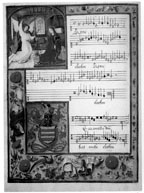Introduction to Music - Western Music: How Did it Begin? by Sarah Choukah
/ January 31, 2003
Version française...
 The origins of "Western music" lie in the early
Middle Ages and the plainsong of the Church of Rome. Until the end of the Middle
Ages, the development and spread of music was inherently linked to religious
ceremonies. Singing was used primarily for the rites of Holy Communion and other
ceremonial gatherings of the Church. In such circumstances music was as simple
and pure as possible, justifying the choice of monody (a single voice line, as
compared to polyphony) and the absence of defined rhythm (measured rhythm would
only appear in the thirteenth century). This pared-down, self-sufficient
liturgical music became enriched through the efforts of St. Ambrose, the
fourth-century bishop of Milan. He discovered eastern modes, in particular the
hymns of the Byzantine Church with a scale structure borrowed from Greek modes,
where intervals between notes were smaller. Ambrose used these modes in the
liturgical music of the mass. The singing became more fluid, more sinuous. Soon
he was leaving behind even the classical Greek modes. The origins of "Western music" lie in the early
Middle Ages and the plainsong of the Church of Rome. Until the end of the Middle
Ages, the development and spread of music was inherently linked to religious
ceremonies. Singing was used primarily for the rites of Holy Communion and other
ceremonial gatherings of the Church. In such circumstances music was as simple
and pure as possible, justifying the choice of monody (a single voice line, as
compared to polyphony) and the absence of defined rhythm (measured rhythm would
only appear in the thirteenth century). This pared-down, self-sufficient
liturgical music became enriched through the efforts of St. Ambrose, the
fourth-century bishop of Milan. He discovered eastern modes, in particular the
hymns of the Byzantine Church with a scale structure borrowed from Greek modes,
where intervals between notes were smaller. Ambrose used these modes in the
liturgical music of the mass. The singing became more fluid, more sinuous. Soon
he was leaving behind even the classical Greek modes.
The Ambrosian chant spread
throughout Europe so successfully that it was adopted and altered in faraway
lands, where it came under the influence of regional languages and musical
modes. The Church, anxious to preserve the pure and universal nature of its
music, wished to prevent this. Writing notes down on paper occurred in the
seventh century, when various signs were used to codify how to sing in church.
At the beginning, notation was simply an aid to memory. Then it developed into
proportional notation, with a four-line staff and square or diamond-shaped
notes.
The cadence as a basic element makes it possible to study forms after this
period. Leo Stein defined it as a moment of rest marking the end of a phrase or
section, noting that the word "cadence" was derived from the Latin cadere
(to fall), since a feeling of caesura or pause was
implicit in the sound of a low note followed immediately by a higher one. This
analogy between spoken and sung phrases is important because it provides a key
to formal construction.
Religious music within the confines of the medieval Church did not develop
much, since religious authorities were concerned with preserving it unchanged.
Outside the Church, however, it exerted great influence on secular music.
Cadences had been used to give rhythm to religious singing and provide reference
points. In popular songs they served as a form of punctuation and organization.
Songs with very simple melodies and rhythms were made up of short couplets with
differing texts. The invention of the bar, attributed to troubadours and
trouvères of France (wandering minstrel-poets of the
north and south respectively), provided rhythmic unity and precision. The use of
the bar gradually ousted plainsong and had a tremendous influence on written
music.
Form becomes more complex
Now music was ready to become more complex and provide pleasure for all. In
The Evolution of Musical Form, (London: Oxford University Press, 1943.) Edward
C. Bairstow notes certain pivotal occurrences in the growth of form. He points
out that works of art display characteristics that can be divided into two
categories: those that express unity and those that provide variety. He adds
that the unifying elements are common to all works, and some, like rhythmic
patterns, have been common to the music of all time. Rhythmic patterns are more
easily memorized by ear, so it's no surprise to learn that they can also be used
to differentiate melodic themes that, through contrast and repetition, are the
basis for developing various parts of a work.
The best known musical form is certainly the ABA, where A designates the
principal section, and B a contrasting section in another key. Thousands of
arias in operas, oratorios, and cantatas have used this form, as have many
instrumental pieces.The minor ternary (ABA) form is the precursor of such dance
forms as the minuet, march, waltz, or scherzo, which have the same tripartite
organization but provide contrast through rhythm, the number of reprises, changes in
harmony, and so forth.
The influence of these minor
dance forms is far from negligible. They are the forerunners of major forms such
as the sonata, or minor forms enlarged through repetition. They have provided
basic material for many composers, not to mention analysts and theoreticians who
are forever giving new interpretations to the monuments of our musical
history.
[Translated by Jane
Brierley]
Version française... |
|


